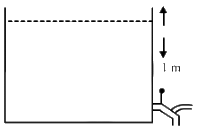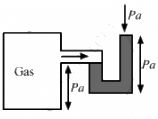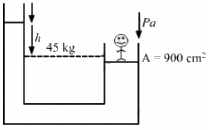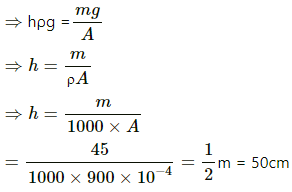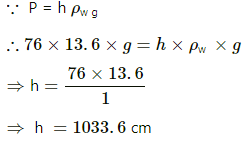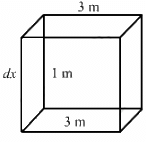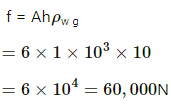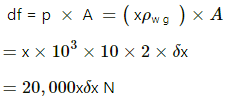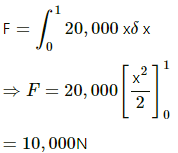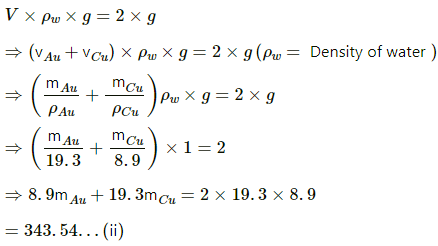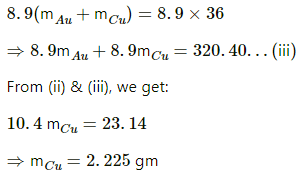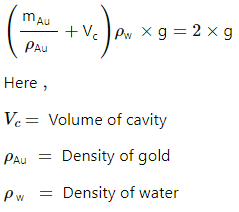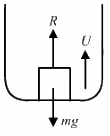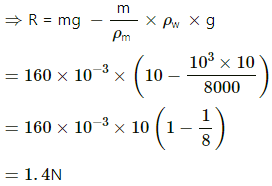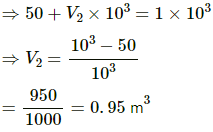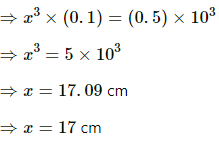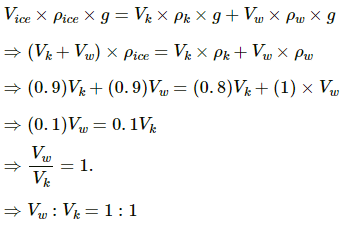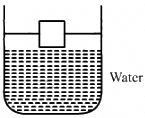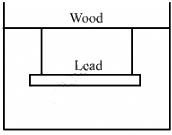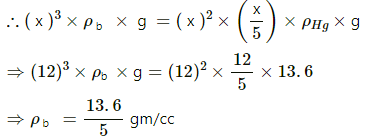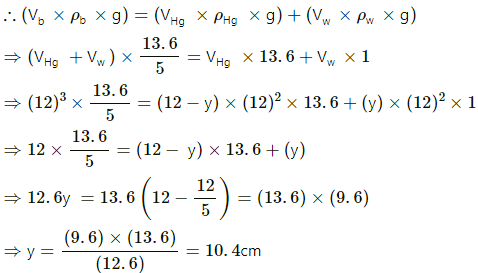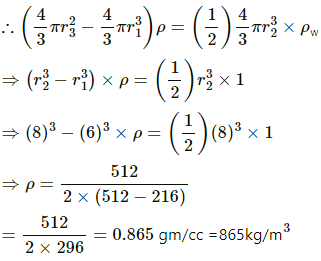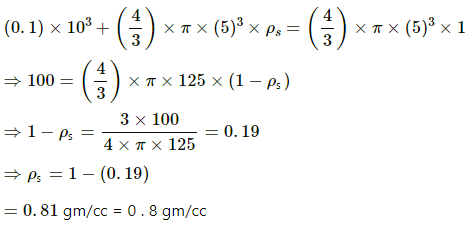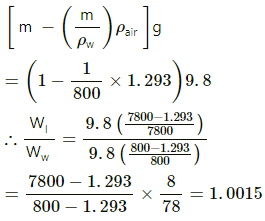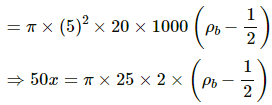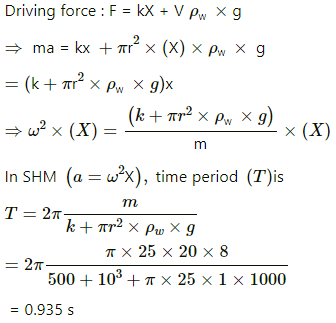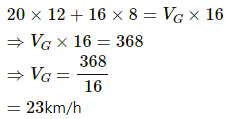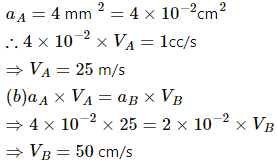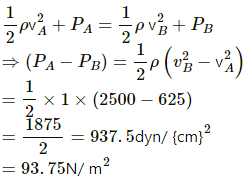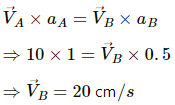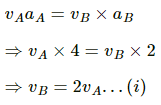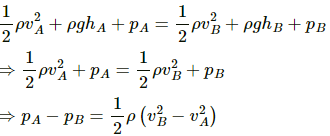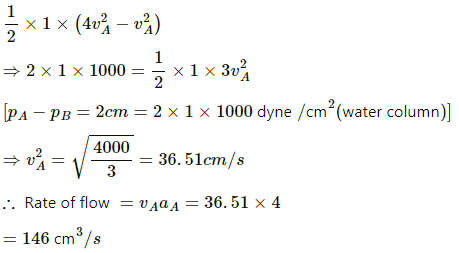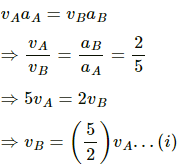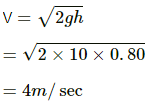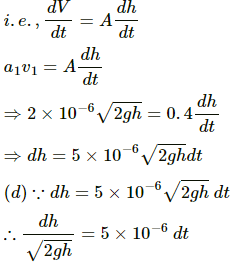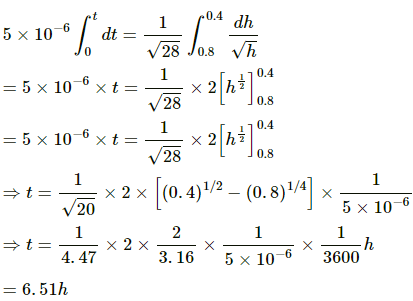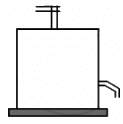HC Verma Questions and Solutions: Chapter 13: Fluid Mechanics- 2 | HC Verma Solutions - JEE PDF Download
Exercise
Q.1. The surface of water in a water tank on the top of a house is 4 m above the tap level. Find the pressure of water at the tap when the tap is closed. Is it necessary to specify that the tap is closed?
Given:
Height of the water tank above the tap level, h = 4 m
Acceleration due to gravity, g = 10 m/s2
Density of water, ρ = 103 kg/m3
When the tap is closed, the pressure of the water in the tap is
P = hρg
On substituting the respective values in the formula, we get:
P = 4 × 103 × 10
= 40,000 N/m2
It is necessary to specify that the tap is closed because if the tap is open, then the pressure gradually decreases as h decreases and also because the pressure in the tap is atmospheric.
Q.2. The heights of mercury surfaces in the two arms of the manometer shown in figure are 2 cm and 8 cm.
Atmospheric pressure = 1.01 × 105 N−2. Find (a) the pressure of the gas in the cylinder and (b) the pressure of mercury at the bottom of the U tube.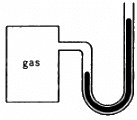
(a) Given:
Height of the first arm, h1 = 8 cm
Height of the second arm, h2 = 2 cm
Density of mercury, ρHg = 13.6 gm/cc
Atmospheric pressure, pa = 1.01 × 105 N/m2 = 1.01 × 106 dyn/cm2
Now,
Let pg be the pressure of the gas.
If we consider both limbs, then the pressure at the bottom of the tube will be the same.
According to the figure, we have:
pg + ρHg × h2 × g = Pa + ρHg × h1 g
⇒ Pg =Pa +ρHg × g(h1-h2)
=1.01 ×106+13.6 ×980 ×(8-2) dyn/cm2
=(1.01 ×106+13.6 ×980 ×6)dyn/cm2
= 1.09 × 105N/m2
(b) Pressure of the mercury at the bottom of the U-tube:
PHg =Pa + ρHg×h1×g
=1.01×106+13.6×8×980
=1.12×105N/m2
Q.3. The area of cross section of the wider tube shown in figure is 900 cm2. If the boy standing on the piston weighs 45 kg, find the difference in the levels of water in the two tubes.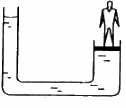
Given:
Area of the wider tube, A = 900 cm2
Weight of the boy, m = 45 kg
Density of water, ρ = 103 kgm−3
Let h be the difference in the levels of water in the tubes and pa be the atmospheric pressure.
As per the figure, we have:
Pa + hρg = Pa + (mg/A)
Q.4. A glass full of water has a bottom of area 20 cm2, top of area 20 cm2, height 20 cm and volume half a litre.
(a) Find the force exerted by the water on the bottom.
(b) Considering the equilibrium of the water, find the resultant force exerted by the sides of the glass on the water. Atmospheric pressure = 1.0 × 105 N/m2. Density of water 1000 kg/m3 and g = 10 m/s2. Take all numbers to be exact.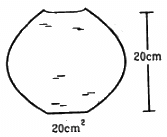
Given:
Atmospheric pressure, pa = 1.0 ×105N/m2
Density of water, ρw =103kg/m3
Acceleration due to gravity, g =10m/s2
Volume of water , V = 500 mL ≈ 500g ≈ 0.5 kg
Area of the top of the glass, A = 20 m2
Height of the glass, h = 20 cm
(a) Force exerted on the bottom of the glass = Atmospheric force + Force due to cylindrical water column or glass
=pa × A + A × h × ρw × g
=A(ρa + hρwg)
=20×10-4(105+20 ×10-2 ×103 ×10)
=204 N
(b) Let Fs be the force exerted by the sides of the glass. Now, from the free body diagram of water inside the glass, we can find out the resultant force exerted by the sides of the glass.
Thus, we have:
Pa × A + mg = A × h × ρw × g + Fs + Pa × A
⇒ mg = A × h × ρw × g + Fs
⇒ 0.5 × 1 = 20 × 10-4 × 20 × 10-2 × 10-3 × 10 + Fs
⇒ Fs = 5 - 4 = 1N (upward)
Q.5. Suppose the glass of the previous problem is covered by a jar and the air inside the jar is completely pumped out. (a) What will be the answers to the problem? (b) Show that the answers do not change if a glass of different shape is used provided the height, the bottom area and the volume are unchanged.
When the glass is covered by a jar and the air is pumped out of the jar, atmospheric pressure has no effect on the glass.
(a) Force exerted on the bottom:
(hρwg) × A
=(20 × 10-2 × 103 × 10)20 × 10-4
= 4N
(b) mg = h × ρw × g × A + Fs
⇒ Fs = 5 - 4 =1N
(c) If we use a glass of different shape with same volume, height and area, then there will not be any change in the answer.
Q.6. If water be used to construct a barometer, what would be the height of water column at standard atmospheric pressure (76 cm of mercury)?
Case: When water is used in a barometer instead of mercury
Pressure exerted by 76 cm of mercury column, P = 76 × 13.6 × g dyn/cm2
Density of water, ρw = 103 kg/m3
Let h be the height of the water column
Q.7. Find the force exerted by the water on a 2 m2 plane surface of a large stone placed at the bottom of a sea 500 m deep. Does the force depend on the orientation of the surface?
Given:
Depth of the stone from the water surface, h = 500 m
Area of the plane surface of the large stone, A = 2 m2
Density of water, ρw = 103 kgm−3
Force (F) is given by
The force does not depend on the orientation of the rock when the surface area of the stone remains the same.
Q.8. Water is filled in a rectangular tank of size 3 m × 2 m × 1 m.
(a) Find the total force exerted by the water on the bottom surface on the tank.
(b) Consider a vertical side of area 2 m × 1 m. Take a horizontal strip of width δx metre in this side, situated at a depth of x metre from the surface of water. Find the force by the water on this strip.
(c) Find the torque of the force calculate in part (b) about the bottom edge of this side.
(d) Find the total force by the water on this side.
(e) Find the total torque by the water on the side about the bottom edge. Neglect the atmospheric pressure and take g = 10 ms−2.
Dimensions of the rectangular tank:
Length, l = 3 m
Breadth, b = 2 m
Height, h = 1 m
Area of the bottom surface of the tank, A = 2 × 3 = 6 m2
Density of water, ρw = 1000 kgm−3
(a) Total force exerted by water on the bottom surface of the tank:
(b) Force exerted by water on the strip of width δx:
(c) Inside the tank, the water force acts in every direction due to adhesion. Therefore, torque is given by
(d) Total force exerted by water on the side about the bottom edge (F) :
(e) Torque by the water on the side (T):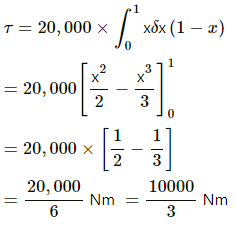
Q.9. An ornament weighing 36 g in air, weighs only 34 g in water. Assuming that some copper is mixed with gold to prepare the ornament, find the amount of copper in it. Specific gravity of gold is 19.3 and that of copper is 8.9.
Given:
Weight of the ornament in air, m1a = 36 gm
Weight of the ornament in water, m2w = 34 gm
Specific gravity (density) of gold, ρAu = 19.3 gm/cc
Specific gravity (density) of copper, ρCu = 8.9 gm/cc
Using Archimedes' principle, we get:
Loss of weight = Weight of displaced water
= 36 − 34
= 2 gm
Let mAu and mCu be the masses of gold and copper, respectively.
Now, the mass of the ornament (mc) will be
mc = mAu + mCu= 36 gm ...(i)
Now, let the volume of the ornament in cm be V.
Thus, we have:
From (i) and (ii), we get:
Therefore, the amount of copper present in the ornament is 2.2 gm.
Q.10. Refer to the previous problem. Suppose, the goldsmith argues that he has not mixed copper or any other material with gold, rather some cavities might have been left inside the ornament. Calculate the volume of the cavities left that will allow the weights given in that problem.
Given:
Mass of copper, mAu = 36 gm
Now,
On substituting the respective values, we get:
Q.11. A metal piece of mass 160 g lies in equilibrium inside a glass of water. The piece touches the bottom of the glass at a small number of points. If the density of the metal is 8000 kg/m3, find the normal force exerted by the bottom of the glass on the metal piece.
Given:
Mass of the metal piece, m =160 gm = 160 × 10−3 kg
Density of the metal piece, ρm = 8000 kg/m3
Density of the water, ρw = 1000 kg/m3
Let R be the normal reaction and U be the upward thrust.
From the diagram, we have:
mg = U + R
⇒ R = mg −Vρwg [U = Vρwg]
Q.12. A ferry boat has internal volume 1 m3 and weight 50 kg.(a) Neglecting the thickness of the wood, find the fraction of the volume of the boat immersed in water.(b) If a leak develops in the bottom and water starts coming in, what fraction of the boat's volume will be filled with water before water starts coming in from the sides?
Given:
Mass of the ferryboat, m = 50 kg
Internal volume, V = 1 m3 = External volume of the ferry boat
Density of water, ρw = 103 kg/m3
(a) Let V1 be the volume of the boat inside the water. It is equal to the volume of the water displaced in m3.
As the weight of the boat is balanced by the buoyant force, we have:
(b) Let V2 be the volume of the boat filled with water before water starts coming in from the side.[V is the volume of the water displaced by the boat.]
Fraction of the boat's volume filled with water = 19/20.
Q.13. A cubical block of ice floating in water has to support a metal piece weighing 0.5 kg. Water can be the minimum edge of the block so that it does not sink in water? Specific gravity of ice = 0.9.
Given:
Specific gravity of ice, ρice = 0.9 gm/cc
Weight of the metal piece, m = 5 kg
Density of water, ρw = 103 kg/m3
Let x be the minimum edge of the ice block in cm.
We have:
mg + Wice = U
Here,
U = Upward thrust
Wice = Weight of the ice
Thus, we have:
Q.14. A cube of ice floats partly in water and partly in K.oil (in the following figure). Find the ratio of the volume of ice immersed in water to that in K.oil. Specific gravity of K.oil is 0.8 and that of ice is 0.9.
Given:
Specific gravity of water, ρW = 1 gm/cc
Specific gravity of ice, ρice = 0.9 gm/cc
Specific gravity of kerosene oil, ρk = 0.8 gm/cc
Now,
Vice = Vk + Vw
Here,
Vk = Volume of ice inside kerosene oil
Vw = Volume of ice inside water
Vice = Volume of ice
Thus, we have:
Q.15. A cubical box is to be constructed with iron sheets 1 mm in thickness. What can be the minimum value of the external edge so that the cube does not sink in water? Density of iron = 8000 kg/m3 and density of water = 1000 kg/m3.
Given:
Density of iron, ρI = 8000 kg/m3 = 8 gm/u
Density of water, ρw = 1000 kg/m3 = 1 gm/u
Let x be the external edge of iron.
According to Archemedes' principle,
Weight displaced = Upward thrust
∴ w = u
For the given condition, we have:
Weight of the box = Buoyant force
⇒ V1 ρIg = vρwg
⇒ (x2 × (0.1) × 6) × 8 = x3 × 1 [Volume of iron = v1 = 6 times the volume of each sheet]
⇒ x = 4.8 cm
Q.16. A cubical block of wood weighing 200 g has a lead piece fastened underneath. Find the mass of the lead piece which will just allow the block to float in water. Specific gravity of wood is 0.8 and that of lead is 11.3.
Given:
Density of wood, ρw = 0.8 gm/cc
Density of lead, ρpb = 11.3 gm/cc
Weight of the cubical wood block, mw = 200 g
The cubical block floats in water.
Now,
(mw+ mpb) × g = (Vw + Vpb)ρ × g
Here,
ρ = Density of water
Vw = Volume of wood
Vpb = Volume of lead
Q.17. Solve the previous problem if the lead piece is fastened on the top surface of the block and the block is to float with its upper surface just dipping into water.
Given:
Mass of wood, mw = 200 g
Specific gravity of wood, ρW = 0.8 gm/cc
Specific gravity of lead, ρPB= 11.3 gm/cc
We know:
Mg = w
Thus, we have:
Q.18. A cubical metal block of edge 12 cm floats in mercury with one fifth of the height inside the mercury. Water in it. Find the height of the water column to be poured.
Specific gravity of mercury = 13.6.
Given:
Length of the edge of the metal block, x = 12 cm
Specific gravity of mercury, ρHg = 13.6 gm/cc
It is given that 1/5th of the cubical block is inside mercury initially.
Let ρb be the density of the block in gm/cc.Let y be the height of the water column after the water is poured.
∴ Vb = VHg + Vw = (12)3
Here,
VHg = Volume of the block inside mercury
Vw = Volume of the block inside water
Q.19. A hollow spherical body of inner and outer radii 6 cm and 8 cm respectively floats half-submerged in water. Find the density of the material of the sphere.
Given:
Inner radius of the hollow spherical body, r1 = 6 cm
Outer radius of the hollow spherical body, r2 = 8 cm
Let the density of the material of the sphere be ρ and the volume of the water displaced by the hollow sphere be V.
If ρw is the density of water, then:
Weight of the liquid displaced =
We know:
Upward thrust = Weight of the liquid displaced
Q.20. A solid sphere of radius 5 cm floats in water. If a maximum load of 0.1 kg can be put on it without wetting the load, find the specific gravity of the material of the sphere.
Given:
Radius of the sphere, r = 5 cm
Mass of the maximum load, m = 0.1 kg
Let the weight of the sphere be W1 and the weight of the load be W2.
Now,
W1 + W2 = U
Here, U is the upward thrust.
Let V be the volume of the sphere.
Thus, we have:
Here,
ρs = Density of the sphere in gm/cc
ρW = Density of water
On substituting the respective values in the above equation, we get:
Q.21. Find the ratio of the weights, as measured by a spring balance, of a 1 kg block of iron and a 1 kg block of wood. Density of iron = 7800 kg/m3, density of wood = 800 kg/m3 and density of air = 1.293 kg/m3.
Given:
Density of iron, ρI= 7800 kgm−3
Density of wood, ρw = 800 kgm−3
Density of air, ρair = 1.293 kgm−3
Net weight of Iron (W1) :
Here, mI and VI are the mass and volume of the iron, respectively.
Now,
Net weight of wood = WW = mwg - VW.ρair g
Here, mw and Vw are the mass and volume of the wood, respectively
Now,
Q.22. A cylindrical object of outer diameter 20 cm and mass 2 kg floats in water with its axis vertical. If it is slightly depressed and then released, find the time period of the resulting simple harmonic motion of the object.
Given:
Outer diameter of the cylindrical object, d = 20 cm
∴ Radius, r = d/2 = 10cm
Mass of the object, m = 2 kg
When the object is depressed into water, the net unbalanced force causes simple harmonic motion.
Let x be the displacement of the block from the equilibrium position.
Now,
Driving force = U = Vρwg
Here,
U is the upward thrust.
V is the volume.
ρw is the density of water.
Thus, we have:
Therefore, the required time period is 0.5 second.
Q.23. A cylindrical object of outer diameter 10 cm, height 20 cm and density 8000 kg/m3 is supported by a vertical spring and is half dipped in water as shown in figure. (a) Find the elongation of the spring in equilibrium condition. (b) If the object is slightly depressed and released, find the time period of resulting oscillations of the object. The spring constant = 500 N/m.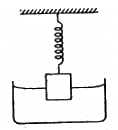
Given:
Diameter of the cylindrical object, d = 10 cm
∴ Radius, r = 5 cm
Height of the object, h = 20 cm
Density of the object, ρb = 8000 kg/m3 = 8 gm/cc
Density of water, ρw = 1000 kg/m3
Spring constant, k = 500 N/m = 500 × 103 dyn/cm
(a) Now,
F + U = mg [F = kx]
Here, U is the upward thrust and x is the small displacement from the equilibrium position.
kx + Vρwg = mg
(b) We know that X is the displacement of the block from the equilibrium position.
Now,
Q.24.1. A wooden block of mass 0.5 kg and density 800 kg/m3 is fastened to the free end of a vertical spring of spring constant 50 N/m fixed at the bottom. If the entire system is completely immersed in water, find the elongation (or compression) of the spring in equilibrium.
Given:
Mass of the wooden block, m = 5 kg
Density of the block, ρ = 800 kg/m3
Spring constant, k = 50 N/m
Density of water, ρw = 1000 kg/m3
Using the free body diagram, we get:
mg = kx + Vρwg (Here, Vρwg > mg. So, there will be some elongation.]
Q.24.2. A wooden block of mass 0.5 kg and density 800 kg/m3 is fastened to the free end of a vertical spring of spring constant 50 N/m1 fixed at the bottom. If the entire system is completely immersed in water, find the time-period of vertical oscillations of the block when it is slightly depressed and released.
Given:
Mass of the wooden block, m = 5 kg
Density of the block, ρ = 800 kg/m3
Spring constant, k = 50 N/m
Density of water, ρw = 1000 kg/m3
As the system is inside the water, the unbalance force will be the driving force, which is kx for SHM.
Hence, there will be no change in the buoyant force.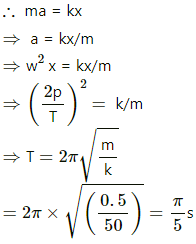
Q.25. A cube of ice of edge 4 cm is placed in an empty cylindrical glass of inner diameter 6 cm. Assume that the ice melts uniformly from each side so that it always retains its cubical shape. Remembering that ice is lighter than water, find the length of the edge of the ice cube at the instant it just leaves contact with the bottom of the glass.
Let the length of the edge of the ice block when it just leaves contact with the bottom of the glass be x and the height of water after melting be h.
Given:
Inner diameter of the cylindrical glass = 6 cm
∴ Inner radius, r = 3 cm
Edge of the ice cube = 4 cm
Weight = Upward thurst
Again, volume of the water left from the melting of the ice is given by
On solving the above equation, we get:
x = 2.26 cm
Q.26. A U-tube containing a liquid is accelerated horizontally with a constant acceleration a0. If the separation between the vertical limbs is l, find the difference in the heights of the liquid in the two arms.
Let a0 be the acceleration with which U-tube is accelerated horizontally. So, the horizontal part will experience some inertial force.
Also,
pa = Atmospheric pressure
A = Area of cross section
h = Increase in height of the liquid
According to the question,
Q.27. At Deoprayag (Garwal, UP) river Alaknande mixes with the river Bhagirathi and becomes river Ganga. Suppose Alaknanda has a width of 12 m, Bhagirathi has a width of 8 m and Ganga has a width of 16 m. Assume that the depth of water is same in the three rivers, Let the average speed of water in Alaknanda be 20 km/h and in Bhagirathi be 16 km/h. Find the average speed of water in the river Ganga.
Given:
Average speed of water in Alaknanda = 20 kmh−1
Average speed of water in Bhagirathi = 16 kmh−1
Width of Bhagirathi = 8 m
Width of Alaknanda = 12 m
Width of Ganga = 16 m
Now,
Volume of water discharged from Alaknanda + Volume of water discharged from Bhagirathi = Volume of water flow in Ganga
Let:
d = Depth of the three rivers
⇒VA × d × 12 + VB × d × 8 = VG × d × 16
Here, VA, VB and VG be the average speeds of water in Alaknanda, Bhagirathi and Ganga, respectively.
Using the equation of continuity, we get:
Q.28. Water flows through a horizontal tube of variable cross section. The area of cross section at A and B are 4 mm2 and 2 mm2 respectively. If 1 cc of water enters per second through A, find (a) the speed of water at A, (b) the speed of water at B and (c) the pressure difference PA − PB.
(a) Given:
The areas of cross-sections of the tube at A and B are 4 mm2 and 2 mm2, respectively.
1 cc of water enters per second through A.
Let:
ρ = Density of the liquid
PA = Pressure of liquid at A
PB = Pressure of liquid at B
Given:
(c) By Bernoulli's equation, we have:
Q.29. Suppose the tube in the previous problem is kept vertical with A upward but the other conditions remain the same. the separation between the cross sections at A and B is 15/16 cm. Repeat parts (a), (b) and (c) of the previous problem. Take g = 10 m/s2.
Given:
Separation between the cross sections at A and B = 15/16 cm
Speed of water at A, vA = 25 cm/s
Speed of water at B, vB = 50 cm/s
(c) By Bernoulli's equation, we get:
= 0
Q.30. Suppose the tube in the previous problem is kept vertical with B upward. Water enters through B at the rate of 1 cm3/s. Repeat parts (a), (b) and (c). Note that the speed decreases as the water falls down.
Water enters through B at the rate of 1 cm3s−1.
(a) Speed of water at A,
(b) Speed of water at B,
(c) By Bernoulli's equation, we have:
=1875 dyn /cm2=188 N/m2
Q.31. Water flows through a tube shown in figure. The area of cross section at A and B are 1 cm2 and 0.5 cm2 respectively. The height difference between A and B is 5 cm. If the speed of water at A is 10 cm s find (a) the speed at B and (b) the difference in pressures at A and B.
Given:
Difference in the heights of A and B = 5 cm
Area of cross section at A, aa = 1 cm2
Area of cross section at B, ab = 0.5 cm2
Speed of water at A, vA = 10 cms
(a) From the equation of continuity, we have:
The required speed of water at cross section B is 20 cms
(b) From Bernoulli's equation, we get:
Here,
PA and PB are the pressures at A and B, respectively.
hA and hB are the heights of points A and B, respectively.
ρ is the density of the liquid.
On substituting the values, we have:
Therefore, the required pressure difference at A and B is 485 N/m2.
Q.32. Water flows through a horizontal tube as shown in figure. If the difference of heights of water column in the vertical tubes is 2 cm, and the areas of cross section at A and B are 4 cm2 and 2 cm2 respectively, find the rate of flow of water across any section.
Given:
Difference in the heights of water columns in vertical tubes = 2 cm
Area of cross section at A, aA = 4 cm2
Area of cross section at B, aB = 2 cm2
Now, let vA and vB be the speeds of water at A and B, respectively.
From the equation of continuity, we have:
From Bernoulli's equation, we have:
Here,
pA and pB are the pressures at A and B, respectively.
hA and hB are the heights of water columns at point A and B, respectively.
ρ is the density of the liquid.
Thus, we have:
Hence, the required rate of flow of water across any section is 146 cm3/s.
Q.33. Water flows through the tube shown in figure. The areas of cross section of the wide and the narrow portions of the tube are 5 cm2 and 2 cm2 respectively. The rate of flow of water through the tube is 500 cm3 s−1. Find the difference of mercury levels in the U-tube.
Given:
Area of cross section of the wide portions of the tube, aa = 5 cm2
Area of cross section of the narrow portions of the tube, ab= 2 cm2
Now, let va and vb be the speeds of water at A and B, respectively.
Rate of flow of water through the tube = 500 cm3/s
From the equation of continuity, we have:
From the Bernoulli's equation, we have:
Here,
ρ is the density of the fluid.
pA and pB are the pressures at A and B.
h is the difference of the mercury levels in the U-tube.
Now,
Therefore, the required difference is 1.969 cm.
Q.34. Water leaks out from an open tank through a hole of area 2 mm2 in the bottom. Suppose water is filled up to a height of 80 cm and the area of cross section of the tanks is 0.4 m2. The pressure at the open surface and at the hole are equal to the atmospheric pressure. Neglect the small velocity of the water near the open surface in the tank.
(a) Find the initial speed of water coming out of the hole.
(b) Find the speed of water coming out when half of water has leaked out.
(c) Find the volume of eater leaked out using a time interval dt after the height remained is h. Thus find the decrease in height dh in terms of h and dt.
(d) From the result of park (c) find the time required for half of the water to leak out.
Given:
Area of the hole of the water tank = 2 mm2
Height of filled water, h = 80 cm
Area of the cross-section of the tanks, A = 0.4 m2
Acceleration due to gravity, g = 9.8 ms- 2
Pressure at the open surface and at the hole is equal to atmospheric pressure.
(a) Velocity of water:
(b) Velocity of water when the tank is half-filled and h is 80/2, i.e., 40 cm:
(c) Volume:
Volume = Ah =A v dt
Volume of the tank = Ah = V (say)
On integrating, we get:
Thus, the time required to leak half of the water out is 6.51 hours.
Q.35. Water level is maintained in a cylindrical vessel up to a fixed height H. The vessel is kept on a horizontal plane. At what height above the bottom should a hole be made in the vessel so that the water stream coming out of the hole strikes the horizontal plane at the greatest distance from the vessel. 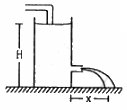
It is given that H is the height of the cylindrical vessel.
Now, let h be the height of the hole from the surface of the tank.
The velocity of water (v) is given by
Also, let t be the time of flight.
Now,
Let x be the maximum horizontal distance.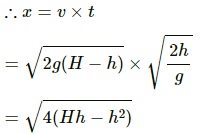
For x to be maximum,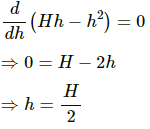
|
134 docs
|
FAQs on HC Verma Questions and Solutions: Chapter 13: Fluid Mechanics- 2 - HC Verma Solutions - JEE
| 1. What is fluid mechanics? |  |
| 2. What are the applications of fluid mechanics? |  |
| 3. How does pressure affect fluid flow? |  |
| 4. What is viscosity in fluid mechanics? |  |
| 5. How is buoyancy related to fluid mechanics? |  |

